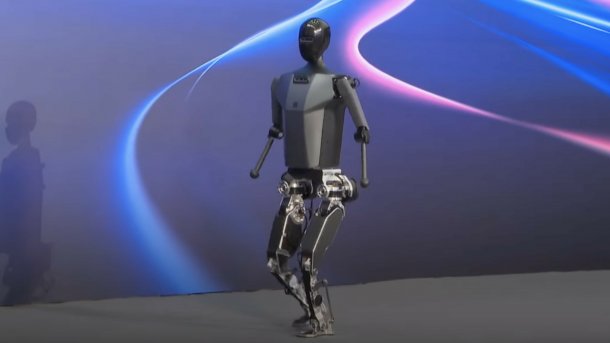China shows humanoid "open source" robot Tiangong
With Tiangong, the Chinese government has made a platform for humanoid robots largely available as open source.

(Image: The State Council The People's Republic of China (Screenshot))
China presented the humanoid robot Tiangong for the first time in the Beijing Economic-Technological Development Area on Saturday. Not much is yet known about the robot. However, it should be able to be used as a general-purpose robot and is largely available as open source.
Tiangong is 1.63 m tall and weighs 43 kg. Its actuators, which move the head, arms and legs in several degrees of freedom, are fully electric. Force feedback is provided by six-axis force sensors. For visual detection, it has cameras and 3D vision sensors as well as other, unspecified sensors. It is said to have a processing capacity of 550 trillion operations per second.
Videos by heise
A video shows Tiangong moving around on two legs. It does this partly autonomously. It can adjust its gait and speed depending on the terrain. However, this does not yet look particularly safe, as the video from the Chinese state-funded broadcaster CGTN shows. Nevertheless, the developers say that the robot is capable of running at a constant speed of 6 km/h.
Humanoid open-source robot
However, there is still a lot of development potential. Unlike commercial robotics companies, Tiangong's state-developed robot platform is largely open source. This means that robotics companies and research institutes can use the robot as a basis for their own developments.
The Chinese government hopes that by opening up the platform, humanoid robots will be developed more quickly for different areas of application in industry so that they can then be used commercially. This fits in with the plan adopted by the Chinese Ministry of Industry and Information Technology in November 2023 to mass-produce humanoid robots from 2025. The plan also envisages that such robots will be able to think, learn and innovate from 2027. This approach is to be accompanied by the industrial mass production of robot components. The first machines for this and individual robot components were presented alongside the Tiangong robot.
However, Tiangong is not the first humanoid robot to come from China. The Chinese robotics company Fourier Intelligence had already presented the humanoid robot GR-1. The Chinese company UBtech Robotics also has a very powerful, human-like robot in its range, the Walker S. It is already being tested in the automotive industry. It is already being used on a trial basis in car production by electric car manufacturer Nio. There are also the CL-1 humanoid robots from LimX Dynamics and the H1 from Unitree, for which the company has already quoted a price of 90,000 US dollars.
(olb)